The Mind’s Map Maker
Yi Gu is on a journey to find out how the brain learns the lay of the land.
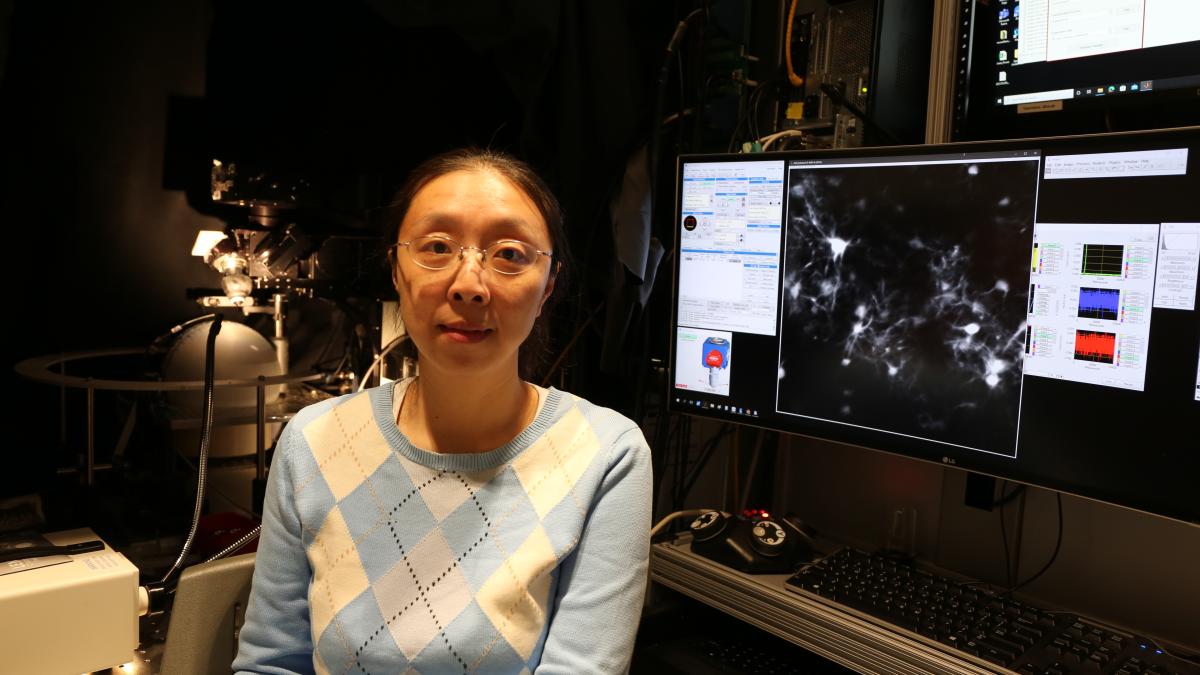
Some people have a keenly tuned sense of direction, while others couldn’t find their way out of a paper bag. Dr. Yi Gu firmly places herself in the latter group.
“I am really bad in spatial navigation,” she admits. “I always get lost.”
Despite her own difficulties getting from point A to point B, Dr. Gu knows more than most about how the brain helps us find our way around. That’s because her lab studies how a particular part of the brain, known as the medial entorhinal cortex (MEC), enables people navigate their environment. The MEC does this by working with another brain area, the hippocampus, to create a ‘cognitive map’ of our surroundings.
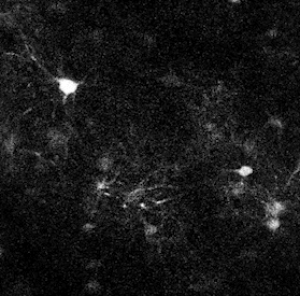
The techniques utilized in Dr. Gu’s lab allow her team to see a mouse’s MEC neurons (pictured above) fire in real-time as it performs a navigation task.
“When you go to a new place, your brain creates a map of the location so the next time you visit, you can still navigate your way around,” Dr. Gu explains. “And when you go to a different location, you have to create a new map so you can recognize the differences between places and do different things.”
Of course, Dr. Gu isn’t pursuing her research just to help her own travel troubles. Several neurological disorders degrade patients’ ability to navigate the world around them. Her research could be especially revealing about the roots of Alzheimer’s disease because problems with spatial awareness are among the illness’s earliest symptoms. What’s more, the tangles of abnormal tau protein thought to contribute to Alzheimer’s first appear in the hippocampus and MEC, resulting in the death of neurons in those areas.

Graduate student Kai Zhang sets up the treadmill that mice use to travel through a virtual reality environment in Dr. Gu’s studies.
Dr. Gu’s unique approach to breaking open the black box of neural navigation begins with figuring out how neurons in the MEC behave in the brains of healthy mice. The animals in her experiments are placed in front of a screen that displays a linear path through a virtual reality environment. To advance through the environment, the mouse runs on a tiny treadmill. While the mouse pursues its virtual reality journey, the activity of the neurons in its MEC is monitored with a special microscope that flings photons — particles of light — at the neurons, which have been genetically manipulated to emit their own light when hit by the incoming photons and glow more brightly when they are more active. The setup also allows Dr. Gu’s team to take advantage of a cutting-edge technique called optogenetics, in which researchers can use light to trigger or suppress the firing of neurons.
“This allows us to not only follow the neurons’ activity, but also influence the activity of individual neurons, or of many neurons at the same time,” she says. “All neurons have different properties. We want to learn what happens when we modulate all the neurons in the MEC or only one specific neuron because it shows a certain pattern of activity.”
Dr. Yi Gu's lab measures the firing of neurons in the brains of mice as they run on a treadmill to journey through a virtual reality environment.
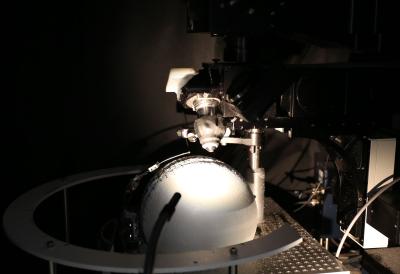
Dr. Gu’s team uses this two-photon microscope to record the activity of a mouse’s MEC neurons during the lab’s experiments.
Indeed, research by Dr. Gu and others in her field has revealed that there are several types of cells in the MEC. Of most interest to Dr. Gu are ‘grid’ cells and ‘cue’ or ‘landmark’ cells. Cue cells play a crucial role in placing areas of interest on the brain’s cognitive map, like marking the location of the White House on a map of Washington, D.C. Grid cells, on the other hand, help you know your own position on that map by firing when you are in certain locations; for example, a certain set of grid cells might fire when you are two blocks east of the White House and another group of cells when you are five blocks north of it. However, studies have shown that grid cells fire in erratic ways in people with Alzheimer’s disease. In fact, Dr. Gu says, the typical pattern of grid cell firing “becomes messier even before their symptoms start to develop, so this could be a way to detect the disease even before symptom onset.”
Since starting her IRP lab, Dr. Gu has made several contributions to our knowledge of how neurons in the MEC help us find our way through the world. One study published in early 2024, for instance, examined how neurons in the MEC behave in mice that quickly learned the layout of virtual environments compared to mice that did not. Her team found that MEC neurons were hyperactive in poor learners, firing at the same high level when the mouse was in a familiar environment it had already ventured through many times and in a new environment it had never seen before. On the other hand, MEC neurons fired more in new environments than in familiar ones in mice that quickly learned to navigate those new environments. This difference suggests that when MEC neurons fire too much, they fail to effectively map new areas.
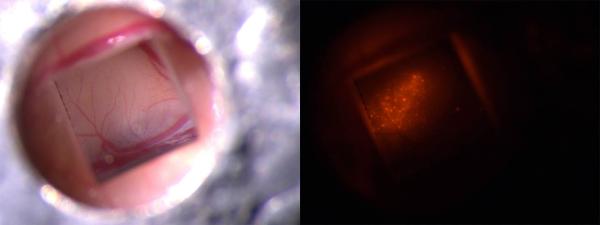
The Gu lab’s two-photon microscope peers into a tiny window in a mouse’s skull that allows the microscope to directly measure the activity of neurons in the MEC, which emit light when hit with photons from the microscope.
The same study also showed that in the poor learners, MEC grid cells fired in a much less consistent way than in the good learners, suggesting that the cells were doing a worse job of reliably telling poor learners where they were in the environment. Further reinforcing this theory, Dr. Gu’s team could disrupt the memory of good learners in a familiar environment by using optogenetics to force their MEC neurons to fire in random ways, effectively causing the mice that had previously been efficient learners to become poor learners.
Dr. Gu’s lab is now replicating that experiment with mouse models of Alzheimer’s disease. Initial results suggest that their MEC cells also fire in inconsistent ways in the same environment, showing some similarities to healthy mice that fail to learn the layout of new surroundings.
“That could suggest when the mice do not learn well, there are some issues with synaptic plasticity, which is a process that helps a neural network to learn and stabilize in a certain state,” Dr. Gu says. “This process is disrupted in Alzheimer’s disease and also in other neurological disorders.”
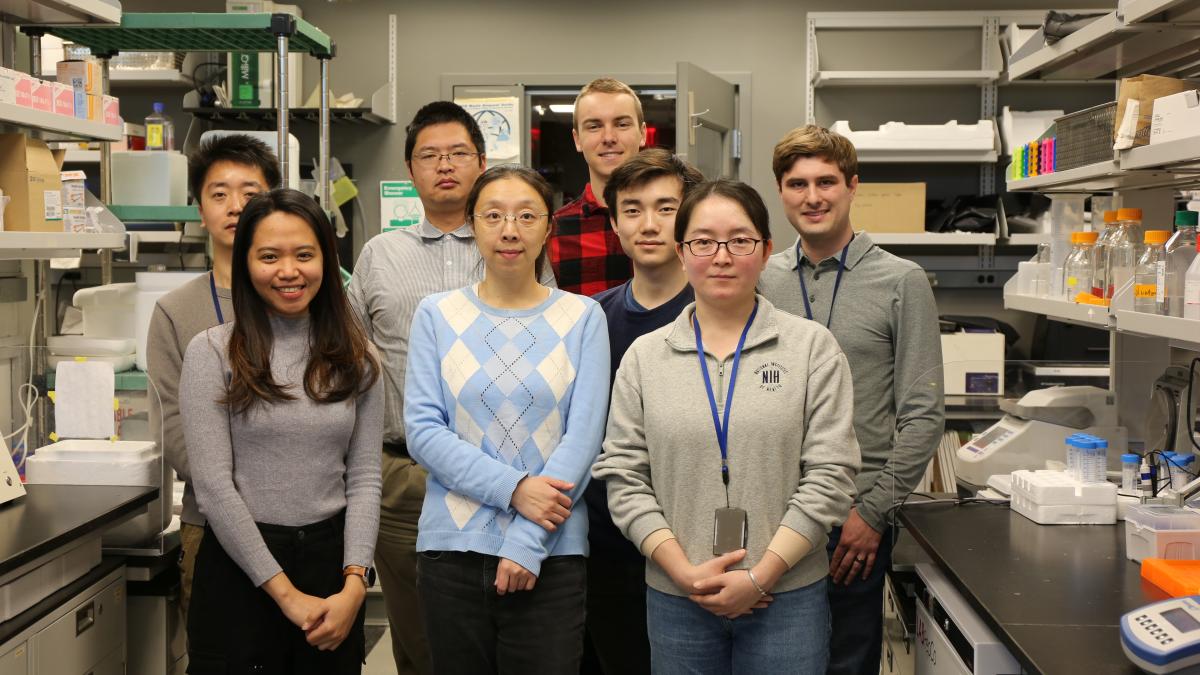
The Gu lab. Back row left to right: graduate student Kai Zhang, postdoctoral fellow Lujia Chen, postbaccalaureate fellow Kyle Cekada, postbaccalaureate fellow Garret Wang, and postdoctoral fellow Taylor Malone. Front row left to right: postdoctoral fellow Ellane Barcelon, Dr. Gu, and lab manager Yan Ma.
Dr. Gu’s experiments with mouse models of Alzheimer’s have only just begun and will be augmented by continued research with healthy animals, including studies looking into how neurons in the MEC alter their production of proteins while animals learn to navigate new environments. She hopes her discoveries will ultimately enable the creation of new ways to treat Alzheimer’s and to diagnose it in its early stages.
Even with that payoff still far in the future, Dr. Gu remains excited to continue digging into the complex array of neurons that create maps of the outside world within our own minds.
“It’s like using your own brain to understand your brain — it seems impossible,” she says. “It’s the complexity, I think, that attracts me because there is a lot that is unknown, and there are a lot more opportunities for discovery.”
Yi Gu, Ph.D., is an IRP Investigator and head of the Spatial Navigation and Memory Unit at the National Institute of Neurological Disorders and Stroke (NINDS).
This page was last updated on Wednesday, March 6, 2024